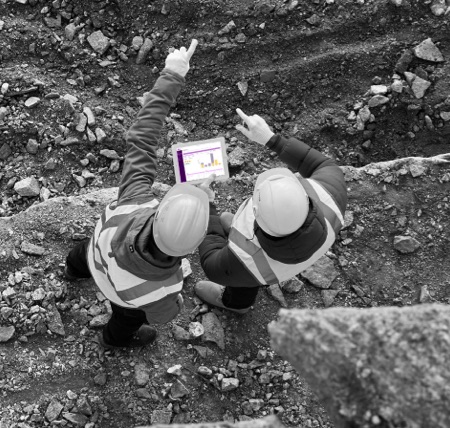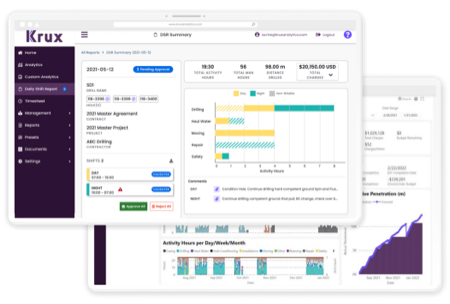Data driller

There's a common refrain Jody Conrad, EMBA’18, keeps hearing from some of her employees these days: “Stop building data dashboards.”
Dashboards are digital tools that help companies (or anyone really; your online financial portfolio is just one example) track, analyze and display data so they can better understand the story behind the numbers.
“You’re the founder and CEO of a booming software company,” say her employees. “You have enough to worry about. Leave the dashboards to your developers.”
But Conrad, who grew up in Saskatchewan, just cannot put the dashboards down.
“I won’t,” she says with a laugh on a recent call while driving between appointments in Calgary. “It’s my favourite thing to do because they’re all about solving problems, and I love helping clients find a problem and solve it.”
Solving problems has always driven Conrad, whether during her 20-plus-year career in the drilling sector or juggling the demands of a young family with two kids. But now, finding solutions to problems goes much deeper — literally.
Since founding Krux Analytics in 2016 from her home in Calgary, Conrad has taken her company global. With offices in Calgary and Perth, Australia, Krux puts its data analytics platform to work with some of the world’s biggest drilling and mining companies on six continents.
One big reason for that rapid growth: Krux was one of the first software companies in the world to offer a reliable alternative to the Excel spreadsheet methods used by most in the mining industry to capture and analyze data.
Krux’s platform is specifically made for drilling. It collects info from mining sites, such as timesheets, daily shift reports and mine survey data, and then converts all that data into those dashboards Conrad is so fond of building, making sure it is in the same format no matter where the data comes from or who inputs it. Normalizing the data in this way makes it easier for companies to see exactly where their time and money are going and allows them to quickly adjust operations to improve efficiencies and lower costs.
Now Krux is encouraging clients to take the next step: real-time data acquisition. This means taking data directly from the drilling instrumentation as it is used. This can give a more advanced understanding of what is happening in the ground so that clients can make better decisions above ground about everything from optimal drilling parameters to carbon emissions. “It’s really cool stuff,” says Conrad. “And it’s the whole reason why I started the business in the first place.”
Conrad came up with the idea for Krux Analytics a few years before the company opened. She was working at Saxon Energy Services, a drilling service provider, and told her boss, Michael McNulty, that she was ready to take the big leap into entrepreneurship. “I was a bit surprised,” remembers McNulty, who now chairs Krux’s board of directors. “But I probably shouldn’t have been. I’d seen at Sax that she was a very driven young lady and wasn’t prepared to just accept the status quo. And so that tenacity, that thinking outside the box she had, was ideal for her to actually jump in and create this new organization.”
By then, Conrad already had lots of experience working in the drilling sector, most of it in the oil and gas industry. After getting a diploma in mechanical engineering technology and later a bachelor’s degree in technology, she worked with a few different companies. They included the oilfield services giant Schlumberger, rig equipment manufacturer Canrig Drilling Technology and then Saxon. She learned everything from designing and building drilling rigs to project management.
But it was when she started doing data analysis in some of these jobs, especially at Saxon, that a lightbulb went off, she says. “It was that optimizing of everything by finding the story in the data that I really enjoyed. And in some of the down patches in oil and gas, you had to cut costs or optimize your business. Cutting costs is one facet, but optimizing actually benefits you long term.”
Initially, Conrad thought that Krux would target drilling operations in oil and gas, and, indeed, some of Krux’s early clients were in that sector. But that all changed after she was accepted into Smith’s Executive MBA program.
She went back to school for a few reasons, one of which was to equip herself with the tools that she thought would help Krux thrive. Her EMBA courses did indeed provide that help, but the most significant lessons came from her classmates, who she says taught her that a big part of being a good leader means being a good team player, surrounding yourself with the right people and listening to your team.
She was certainly listening to a classmate one night in Kingston. They were at a karaoke bar, where, in between sipping whisky and belting out classic rock covers, Conrad told him about Krux and her plans to target the oil and gas sector. He owned a drilling company in the mining industry and suggested she help his firm because it still used a paper system to track and analyze data.
Another lightbulb went off.

Krux works with drilling and mining companies in 15 countries. Ten per cent of drilling rigs worldwide use its analytics platform
“I didn’t even realize that there was this opportunity in mining until that conversation,” says Conrad. “There was this whole other industry that wasn’t as far along as oil and gas in terms of gathering and analyzing data.”
By the time she graduated with her EMBA, Conrad had a new business plan for Krux to target the mining sector. The story since then at Krux has been one of growth.
Krux started in business with only three people: Conrad and two consultants. Eight years later, there are 43 people at Krux working with drilling and mining companies in over 15 countries. Some firms are among the world’s largest in the sector, including Barrick Gold, Newmont and Rio Tinto. Krux’s platform is now used on about 10 per cent of drilling rigs worldwide. By the end of 2025, Conrad believes that number will hit 20 per cent.
The biggest win for clients right now is in how Krux transforms their billing and invoicing processes, says Conrad. Invoice reconciliation is notoriously bad in mining, and there are many ways that companies do their calculations. That makes it tough to see where time and money are spent and therefore harder to identify spots to improve operational efficiencies. The Krux platform, however, standardizes all this info no matter who is entering the data.
Take Barrick Gold. In 2020, after Barrick implemented Krux on a drilling site, it reduced costs per metre drilled by about half. Some of these savings came after Barrick used the platform to see that one drilling rig was spending way more time on standby than others [see story, right]. “That really is the power of the data,” says Conrad. “Until you see it — and see it in the same way across your operations — you can’t action on it.”
Although Krux was one of the first companies to offer a software platform like this, three different companies have released data analytics tools specifically for the mining sector over the last two years, says Conrad. This competitive heat is happening for a few reasons, but the big one is the current boom in metals mining in response to the clean energy transition. That switch requires huge amounts of metals like copper, nickel, cobalt and lithium for electric vehicles, solar panels and grid infrastructure. Some estimate that copper demand alone could grow by over 600 per cent by 2050. The problem is that some mining companies are having a hard time keeping up with this demand, which is why a growing number are turning to software providers like Krux to help them get more minerals out of the ground more efficiently.
As for the future, Conrad expects artificial intelligence will be more integrated into software tools to make drilling operations even more efficient. Yet, she says, “these amazing AI technologies are great tools, but they don’t work without good data. And as the saying goes, ‘Garbage in, garbage out.’ So making sure our customers are entering data into that normalized model, capturing that instrumentation data in real time and at depth, will allow us to take advantage of AI and provide even more value.”
Although he may be biased, McNulty says he wouldn’t bet against Krux continuing to provide that value. And Conrad is a major reason why. “What I’ve seen with Jody and what I find remarkable is how she’s grown as a person and a leader. Very often with entrepreneurs, it’s their way or the highway. But even though Jody is tenacious, she’s not so set in her ways that she won’t consider other ways to do things or get input from people from various backgrounds. And I know her people have a ton of respect for her. I think they’d follow her anywhere.”
Conrad says she couldn’t be prouder of what her team at Krux has accomplished. “This company is my third child — or fourth, if you count my husband,” she laughs. “We have an amazing culture here, amazing people. And I really hope to inspire other women to do this as well. It’s tough, but if you put your heart into it, you can do it. You can do anything.”
That includes building as many data dashboards as you want.
How Krux helped miners blast inefficiency
In the winter of 2020, at a remote northern gold mine, drilling was slow. Krux helped Barrick Gold change that:
Step 1: Implement
Barrick spent a week putting Krux’s platform in place with all four of its on-site drilling contractors.
Step 2: Report
Drilling contractors used Krux to report all hours of their shifts, what they were doing during those hours and what equipment they used.
Step 3: Analyze
From Krux’s platform, Barrick discovered one contractor had high standby times compared to others during blasting. Further investigation found this was because the contractor took 12 hours to move rig operations in/out of the blast zone.
Step 4: Respond
Barrick moved the contractor permanently outside of the blast zone and replaced it with other contractors that can quickly move in and out of the danger area.
Step 5: Result
Combined with other efficiencies discovered with Krux, Barrick cut contractor standby time from 66% to 46% and downtime from 9.5% to 6.1% for a 50% reduction in costs per metre drilled.

